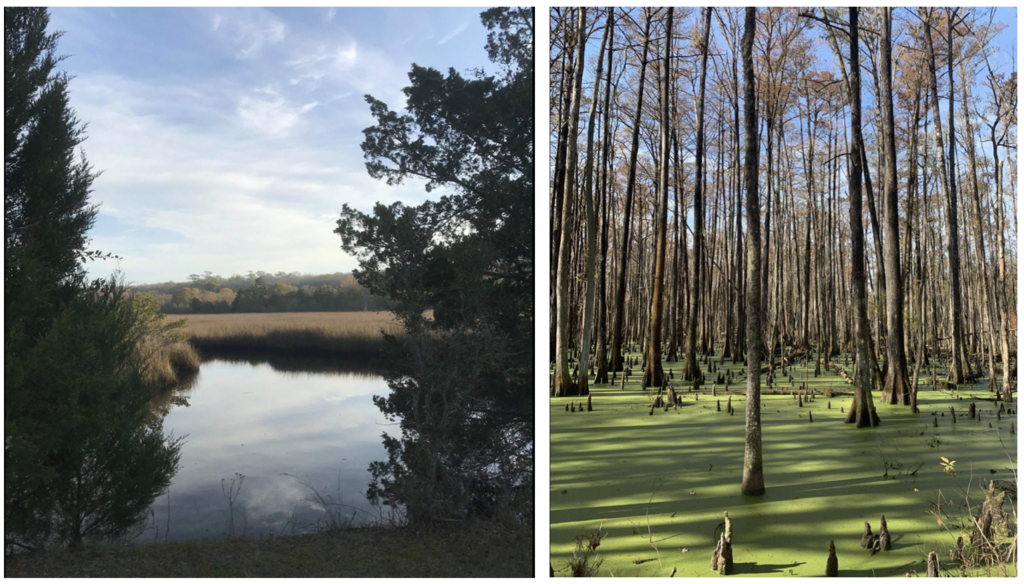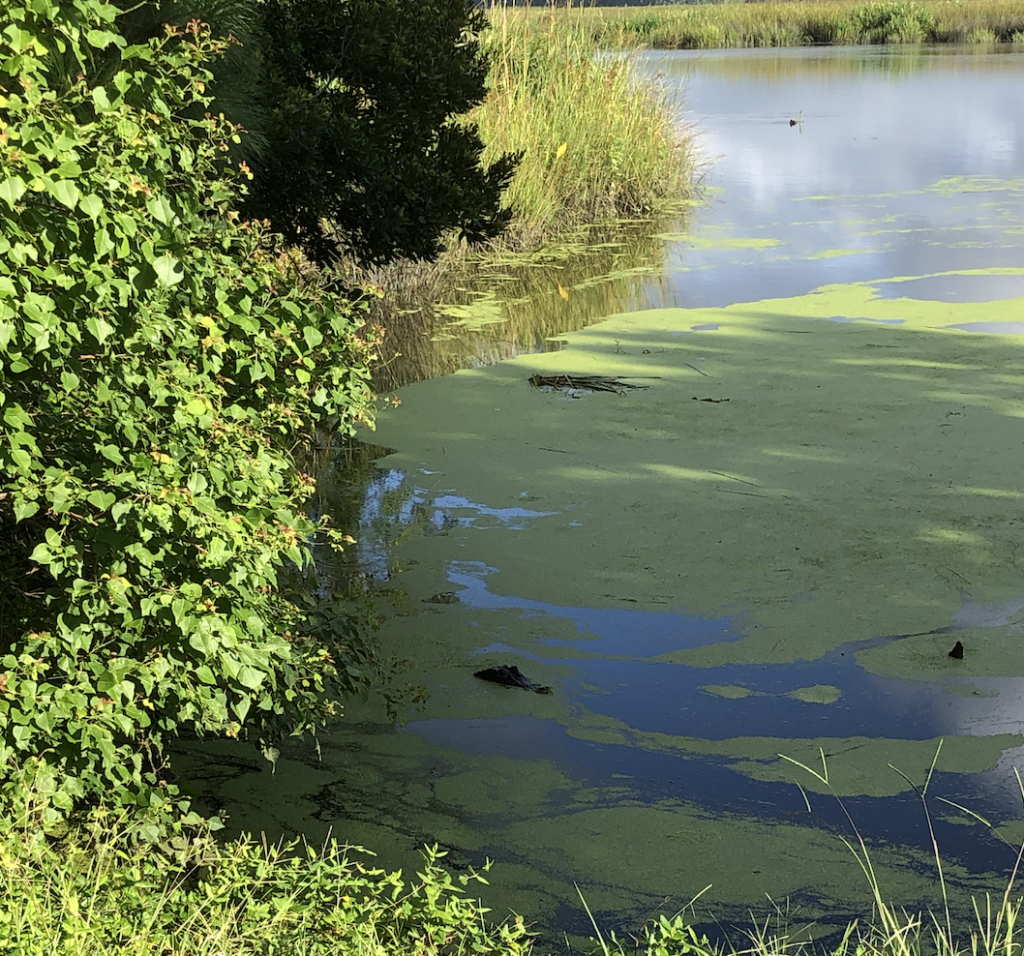Head about twenty miles south on U.S. 17 out of the city and dense development gives way to a rural landscape. Welcome to one of Charleston County’s hidden parks: St. Pauls Parish parks offer something for everyone. Here you’ll find several beautiful, often missed parks that are home to alligators and rare bird species, and which offer breathtaking views of unspoiled lowlands and miles of hiking trails. Historically, St. Paul’s Parish was a rural plantation district surrounded by marshes and wilderness. The town of Ravenel in its midst was a railroad hub for bringing farm goods to the city for sale. It is still a small town today situated between important historic sites and plantation landscapes that are now open as green spaces to escape the city and learn about the Lowcountry’s rice culture.

Caw Caw Interpretive Center is a beautiful site and is brimming with important, if sometimes difficult, Lowcountry agricultural history and was once a rice plantation. Historian Nic Butler explains the growth process: “Rice requires a lot of fresh water, not salt water, to grow. Fields of rice have to be flooded periodically to kill weeds and competing plants, and then drained to allow the rice plants to mature. In order to successfully grow rice, therefore, you have to have a workable plan and a network of physical infrastructure to control the flow of fresh water. South Carolina colonists developed two contrasting methods of rice cultivation in the eighteenth century,” the inland method which draws fresh water from manmade reservoirs, and tidal, which used the natural action of the tides to carefully time a flood of fresh water into the fields using sluice gates or “rice trunks”. Caw Caw is one of the best places to experience the inland rice plantation landscape.

Intricate rice landscapes were made possible through a large, enslaved population, and Caw Caw would have had numerous slave dwellings and farm buildings. An account from 1775 explained how slaves created the landscape: “the first business was to drain the swamp . . . in March, April, and May they plant . . . as soon as planted they let in the water to a certain depth. The great object of the culture is to keep the land free of weeds.” The work would have been daunting. In 1739, the Stono Rebellion, the largest slave uprising in the British mainland American colonies began south of Caw Caw (then the plantations of Thomas Rose and Thomas Elliott). More than 100 enslaved people passed through Caw Caw on their march toward Charleston. The Stanyarne family owned the plantation later, and from 1901 to 1914, the American Tea Growing Company farmed the site.

Today, Charleston County Parks and Recreation manages the 433-acre landscape. CCPRC invites visitors to, “Journey from the past to the present and heritage to habitat at the Ravenel Caw Caw Interpretive Center. Rich in natural, cultural and historical resources, Caw Caw was once part of several rice plantations and home to enslaved Africans who applied their technology and skills in agriculture to carve the series of rice fields out of cypress swamps.” Thousands of tea plants are still present, and the canals and rice dikes are still visible between the cypress trees. There are six miles of hiking trails, an interpretive center to host environmental and social studies programs from preschool to college level, and boardwalks through the rice fields that reverted back to natural swamps where visitors might see bald eagles, various coastal plains birds, and the ubiquitous American Alligator.


Located off of SC Highway 162 between Rantowles and Hollywood, Dungannon Plantation Heritage Preserve is a hidden gem of 643 acres of tupelo gum swamps and upland forest land of longleaf pines and beech that is managed by the South Carolina Department of Natural Resources. The plantation is named for Dungannon township is County Tyrone; presumably, the first owner emigrated from the north of Ireland. An 1827 ad describes it as “that valuable plantation called Dungannon, estate of Benjamin Seabrook, in St. Paul’s Parish, admirably adopted to the culture of cotton and provisions. On the premises are a very large and commodious dwelling house with every necessary outbuilding.” Matthew Sandford owned it in the antebellum era and he was buried on site when he died in 1859.

Dungannon has a large freshwater reserve that was once used to flood the surrounding rice fields. A haven for nesting birds like osprey, anhinga, herons, and egrets, the DNR acquired the site in 1995 to create a preserve for these and the rare and large wood stork to stop while migrating and to nest. The American wood stork was placed on the endangered species list in 1984 but is making a resurgence thanks to preserves like Dungannon. Matt Richardson notes, “this graceful wading bird is unique not only in size, color, and niche in the ecosystem, it also possesses a number of interesting characteristics. It can be observed flying and gliding over the Lowcoutnry with its neck outstretched, almost pterodactyl-like. Its feeds on frogs, fish, and other water creatures by wading along with its slightly opened beak in the water.”

If you trek to beautiful Dungannon, plan ahead: the boardwalk is closed from February to November for wood stork mating season and this pristine natural landscape has no restroom facilities. Dogs are welcome however, and there are miles of secluded trails through the forests.

After your rural hike, the next St. Pauls Parish park is the 4.35-acre Bennett Park on Steplight Road off of Savannah Highway offers athletic amenities including a large field, basketball court, two picnic shelters, and a playground. The site was donated by Abner Bennett in 1992. His daughter Nancy Bennett explained, “it was my daddy’s dream to have someplace for the children to play safe.” The town budgeted $130,000 for the park in 2002 but it did not open until nearly a decade later. There are plans to add a football field and more facilities in the future.

At the end of the line is the quaint town of Ravenel, created in 1859 with 182 half-acre lots and “garden farms” of between 3 and 8 acres. The town was incorporated in 1949 and is still home to just 2,500 people spread out over large rural lots. The town developed around Atlantic Coastline Railroad Depot. The building, with its traditional wide overhangs, was built in 1915 and abandoned in the 1970s before being fully renovated and brought back to life by the Town of Ravenel.

The town masterplan notes, “The railroad served as the center of activity in the Ravenel community and many Ravenel residents were employed by the Atlantic Coast Line. Ravenel was fondly known as “a whistle stop and a watering place for trains.” Other businesses such as lumber companies and grocers began locating along the rail line and passenger trains began making trips between Ravenel and Charleston.” The town post office and telegraph station were once housed in the depot; today, it is used for town sponsored events and is in the midst of a small-town park and playground.

There are restaurants and filling stations nearby, making Ravenel the perfect last stop after a day of hiking through the beautiful St. Pauls Parish parks.

Sources:
- Doar, David. Rice and Rice Planting in the South Carolina Lowcountry. Charleston: Charleston Museum, 1936. Reprint, 1970.
- Charleston Mercury, 11 January 1827.
- BCDCOG, Town of Ravenel. Twenty Year Comprehensive Plan. Adopted May 2020.
- Smith, Hayden R. Carolina’s Golden Fields: Inland Rice Cultivation in the South Carolina Lowcountry, 1670–1860. New York: Cambridge University Press, 2020.
- Tuten, James H. Lowcountry Time and Tide: The Fall of the South Carolina Rice Kingdom. Columbia: University of South Carolina Press, 2010.
- https://www.townofravenel.com
- McCrady plats 1306, 832.
- Plat D-191, Town of Ravenel. Charleston County Deeds Office.
- Melvin Backman. “18 year dream a reality.” Post and Courier, 12 June 2010
- https://www.postandcourier.com/news/18-year-dream-a-reality/article_9c5f27d8-5330-512e-ac0b-7c43f39f6815.html
- https://www2.dnr.sc.gov/ManagedLands/ManagedLand/ManagedLand/120
- https://scgreatoutdoors.com/park-dungannonplantationhp.html
- Nicholas Butler. “Ten things everyone should know about Lowcountry rice.” Charleston Time Machine. https://www.ccpl.org/charleston-time-machine/ten-things-everyone-should-know-about-lowcountry-rice
- https://ccprc.com/53/Caw-Caw-Interpretive-Center
- Matt Richardson. “Nature in its full glory at Dungannon Plantation Heritage Preserve.” Island Packet, 2 June 2014.
- https://www.scpictureproject.org/charleston-county/caw-caw-interpretive-center.html



